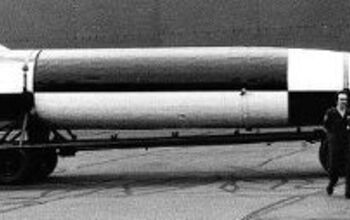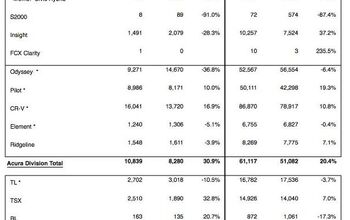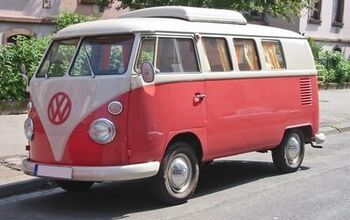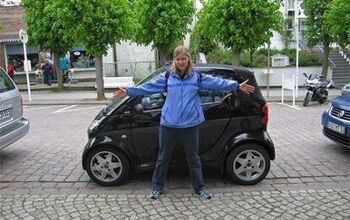Volkswagen's June Sales Up .03%
Volkswagen is amongst the first of the manufacturers sending out its SOS June sales numbers. Despite the numbers and the claim that they're enjoying the "best sales month since August 2006," the picture at VW is grim. if not for the new Tiguan, they'd be cratering with the best (worst?) of them. VeeDub's compact SUV-crossover-thingy sold 1044 units in June. Can the Golf-on-stilts keep-up the big Mo for the rest of the year? Equally worrying, has the Tiguan cannibalized sales of the Jetta and Rabbit, which were both down from last month? That's what should send Volkswagen of America boss Adrian Hallmark running for the Immodium. While a 1500 unit hit doesn't sound a lot, the percentages– Jetta down 11.3%, Rabbit down 18.9%– are straight-up scary. The explanation: unimpressive gas mileage from standard five-cylinder engines. Hello? Volkswagen has fleets of cars in Europe (under three different nameplates) that are all fuel efficient, fun to drive, and don't feel cheap. And none of them was designed or prepared for sale in the United States. A VW lineup including the Fox, Polo, Skoda Fabia or Roomster would be kicking ass in today's gas conscious U.S. market. The new U.S. diesel Jetta is great, but pricey (both to buy and run). Screwing itself, VW is.


































Comments
Join the conversation
KatiePuckrik asked "Is VW a car marque in NA that anyone cares about?" According to http://www.tmcnet.com/usubmit/2008/06/30/3523038.htm "In 2007, Volkswagen delivered 6.2 million vehicles worldwide, 329,000 of them in the United States. VW's share of the U.S. passenger car market was 2 percent, according to its 2007 annual report." Apparently they're looking to open a plant in the U.S. Real Soon Now.
The days of the old beetle times are definitely gone.The Rabbits from the late '70s (Westmoreland production) simply were crap.VW laughted as so many others at Toyota in the '70s, and now they are finding themselves being overtaken as the once prime importer of fuel efficient cars by the Japanese.They got passed already so many years ago and did not get it.Once a VW dealer was a sort of shrine selling the hip vehicles of the decade.Now it's a shrine for ignorance.The greedy German Doctors and engineers are busy stuffing their pockets with dough and financing their union leaders with prostitutes instead of delivering product. Instead of maintaining the peoples car idea they went upscale with the Touareg and Phaeton, proofing- hey big boys we can build real cars too.We can't sell'em, but at least we are being taken seriously now.Well folks at VW, the train of small fuel efficient ,affordable cars already has left the station in the U.S, and you are not on it.
Consumer Guide’s Impressions of the 2010 Volkswagen Polo Volkswagen is poised to take on the Honda Fit and other thrifty minicars with a baby Rabbit that should get 40-60 mpg. It’s the first-ever U.S. Polo, and it will be U.S. made to avoid German-car sticker shock. What We Know About the 2010 Volkswagen Polo Most Americans know the Volkswagen Rabbit hatchback (a.k.a. Golf). Now it looks like we’ll meet its kid brother, the Polo, which has been around since 1975 but has never been sold here before. VW officials said last January that they were considering a smaller-than-Rabbit car for U.S. sale, provided they could get around the weakening dollar that’s making so many euro-denominated imports so expensive. As VW CEO Martin Winterkorn told trade weekly Automotive News, “The car would have to be built in the U.S. To make the Polo in Europe and bring it to America would not work.” That’s still true. So is the general rule about smaller cars making smaller profits, one reason Detroit has paid scant attention to them over the last 10 years. But with record gas prices and rising buyer demand for thriftier vehicles, every automaker is scrambling to get out higher-mpg models, so it’s easy to imagine that a U.S.-market Polo has moved up on VW’s priority list. It’s just as easy to imagine building it at the U.S. VW plant that’s slated to open in 2010 as a prime means for avoiding the weak dollar and consequent sticker shock. VW will soon decide on location--Alabama, Tennessee, and Michigan are in the running--and what the plant will build. Initially, VW said the facility would turn out core American-market models--namely the compact Rabbit and Jetta, a new lower-cost U.S.-only version of the midsize Passat sedan, and probably the just-introduced Tiguan compact SUV (currently sourced from Europe). But even with all three, the plant would still be some 50,000 units below its reported maximum capacity of 200,000 units a year, leaving plenty of room for a made-in-America 2010 Volkswagen Polo. And so much the better for VW, whose recently launched “Strategy 2018” aims to double U.S. and global sales within 10 years in an ambitious bid to pass Toyota as the world’s largest-volume automaker. Then too, U.S. VW dealers certainly need a lower-priced car to take on the Honda Fit, Toyota Yaris, and other fuel-stingy subcompacts that are now flying off the lots. And as luck would have it, a redesigned Polo is due out in Europe later this year, so VW could have the newest econocar on the U.S. market. European sources indicate the 2010 Volkswagen Polo will be about the same overall size as the redesigned 2009 Honda Fit and thus a little larger than the fourth-generation Polo it replaces. Models should comprise several flavors of 4-door hatchback. Two-door versions are possible as well. Styling is said to embody the crisper new corporate look that will mark the redesigned 2010-2011 Rabbit and Jetta. Like so many other small cars--and every Polo to date--the U.S. version has front-wheel drive, a strut-type front suspension, and a simple “twist beam” rear axle. Standard features are expected to include ABS brakes, electric or electro-hydraulic power steering, front side airbags, and curtain side airbags. VW’s ESP antiskid system and traction control may be standard with uplevel trim and will certainly be available. Ditto air conditioning. Options may include premium-class appointments like a navigation system, satellite radio, and sporty appearance and handling upgrades. The days of bare-bones small cars are long gone. The Polo has long offered a wide choice of powertrains. The current fourth-gen line lists small 3- and 4-cylinder gasoline and diesel engines with and without turbocharging that span horsepower ratings ranging from 64 in base models to 180 in the sporty top-line GTI version. Those outputs may seem modest, but they’re more than sufficient for curb weights running around 2500 pounds. For various reasons, the U.S. would probably get only two or three engines. We’d guess the base mill will be a 1.4-liter 4-cylinder with direct gasoline injection and perhaps 110 horses, though this could be an option to a more-miserly 1.2- or 1.3-liter “triple” with around 85 or 90 horses. Another prospect is an ultra-frugal Polo “BlueMotion” with a 1.4-liter 3-cylinder turbodiesel that would make about 80 horsepower and could rate up to 60 mpg in EPA tests by some estimates. A U.S.-based magazine recently reported a budget-pleasing 46 mpg in real-world driving with a 2008 Polo BlueMotion, aided by a specially geared 5-speed manual transmission, narrow low-rolling-resistance tires, and subtle aerodynamic styling tweaks. Availability would depend on clearing the turbodiesel engine with U.S. emissions standards, but VW is now rolling out a larger U.S.-legal “TDI” option for the Jetta, so it can probably qualify the Polo diesel, too. Gasoline models would likely offer a 6-speed manual transmission or the new lower-cost 6-speed DSG automated-manual that’s due to show up soon in other VWs. Like Honda with the Fit, VW has decided that America is ready for a smaller, thriftier car than anything it currently offers. After all, the U.S. motoring landscape is rapidly coming to resemble that of Europe and many other lands where gas costs a small fortune and small cars are the mainstream norm. Assuming it’s the right car at the right price, the Polo could go a long way to helping VW reach its ambitious 2018 sales target. We’ll be watching with interest. Volkswagen brings the Polo to the U.S. for the 2010 model year. The Polo has been available in Europe since 1975. The European Polo BlueMotion is shown here. A Notable Feature of the 2010 Volkswagen Polo VW is planning additional Polo models for Europe and other overseas markets, including an entry-level cloth-top convertible, a new version of the SUV-flavored CrossPolo wagon, and an extended mini-minivan. It’s possible one or all of these could reach the U.S., perhaps by model-year 2012, if only to one-up the competition. The same goes for the sporty 2-door GTI hatchback. More significantly, VW is planning a “mild hybrid” Polo that should be an interesting alternative to Honda’s upcoming “dedicated” hybrid hatchback and the gas/electric Fit expected around 2015, not to mention the sales-leading Toyota Prius. Like the Hondas, the Polo would not run on volts alone, but would include regenerative-braking battery charging and a fuel-saving engine stop/start system. VW recently teamed with Japan’s Sanyo Electric to develop advanced lithium-ion (LI) batteries for hybrid VW vehicles, one of several such joint ventures. Production reportedly begins in 2009. The LI batteries will likely appear in the hybrid Polo despite their relatively high cost, but reports indicate that plug-in capability wouldn’t be available until at least 2011. Buying Advice for the 2010 Volkswagen Polo The Polo has been one of VW’s major moneymakers in many markets, and the redesigned fifth-generation should be no different. Published tests of prior Polos suggest the newbie will be one of the sportier econocar drives, even with a low-power engine. It should also appeal for ride comfort, overall refinement, robust build quality, and high fuel economy. Mediocre value-for-money has been a consistent criticism, but serious number crunching may correct that on the 2010 Volkswagen Polo. Price is definitely up there with mpg as make-or-break factors in U.S. Polo sales, especially against appealing rivals like the Best Buy Nissan Versa and Suzuki SX4, not to mention the redesigned Fit. And new competition is on the way, including the Ford Fiesta and an additional entry just announced for Chevrolet. So to say the least, the Polo will have its work cut out for it. And so will you in deciding among the many choices. Consumer Guide can help you narrow them down, both here online and in the pages of our Car and Truck Test magazines. 2010 Volkswagen Polo Release Date: Though VW hasn’t yet confirmed a U.S.-market Polo, we’d be surprised if the company fails to capitalize on current U.S.-market trends. With the fifth-generation Polo due out soon--and with VW aiming to trim lead times between European and U.S. rollouts--we’d look for U.S. sales to begin in the second or third quarter of 2009 for the 2010 model year. 2010 Volkswagen Polo First Test Drive: If the launch timing above proves out, the Polo would likely meet the U.S. press on U.S. soil by spring of 2009. 2010 Volkswagen Polo Prices: The Polo is intended to be the new bottom rung on VW’s U.S. price ladder, though top-trim versions may overlap with low-end versions of the larger Rabbit. Assuming the necessary number crunching goes well, we’d look for base stickers in the $13,000-$16,000 range.
I don't agree that the TDI is "pricey" to run. With the terrific mileage, even with the slightly higher price of diesel fuel (less than 3% more than Regular in CT), the cost of fuel is low.